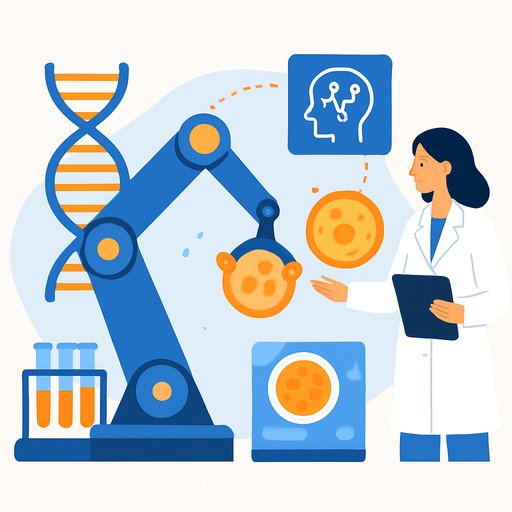Smarter Cell Line Development for Better Biologics with AI
11/11/2025 . 7 min read
Biologics are getting harder. Multispecifics, fusion proteins, and multi-chain formats strain traditional methods. That pressure shifts the real leverage point upstream: cell line development (CLD).
For IT and development teams working in biopharma, this is familiar territory. Early choices compound. Data quality decides outcomes. Automation and machine learning turn a slow, manual pipeline into a faster, more predictable system.
Why CLD matters more than people think
CLD sits early in the CMC flow, but it sets the tone for everything that follows. Pick a clone that underperforms or drifts on quality, and downstream teams inherit the pain: longer timelines, higher costs, and process tweaks that never quite fix the core issue.
The goal is simple: find a stable, high-producing clone fast, and get to clinic sooner. The cost of getting it wrong is felt for years.
Where traditional CLD slows you down
Classic workflows measure productivity late. By the time you see weak performance, you've sunk weeks of effort, and the reset burns time you don't have. Trial-and-error screening adds more delay and variance.
A modern CLD platform flips that script. It measures productivity earlier and feeds that data into smarter selection. Decisions move forward. Risk moves down.
From 2005 to now: the platform story
This platform traces back to Cellca (founded 2005, acquired by Sartorius in 2015). Since then, the team has compressed "DNA to research cell bank" from roughly 14 weeks (2020) to about nine weeks today.
Single-cell cloning and clone selection were rebuilt, making the pipeline leaner for both standard antibodies and complex modalities.
Complex molecules need flexible playbooks
There's no single recipe for bispecifics or multichain formats. Some projects need to screen more clones. Others benefit from an added pool phase to pre-select strong candidates before single-cell cloning.
The platform integrates automation, early productivity reads, and ML-based prediction of later-stage performance. It also supports process and media optimization via design-of-experiments, and can shift production modes (e.g., perfusion or high inoculation) as needed.
Want a quick primer on design of experiments? NIST has a clear overview that many teams reference: NIST DoE Handbook.
AI and automation: what's actually under the hood
Recent generations of the platform use a data-driven approach that learns from historical CLD runs. Multiple ML algorithms score clones early and predict how they'll behave later.
Strict criteria filter candidates so early calls are confident and repeatable. The effect is less guesswork, fewer loops, and better throughput.
Making ML dependable in a lab setting
Models are built with biologists, biotechnologists, and data scientists in the same loop. That keeps inputs relevant, reduces noise, and cuts the risk of overfitting.
Each model is tested against baselines like traditional selection or even random picks to confirm real gains in productivity or other key metrics. The system keeps learning, folding new data back in so future predictions improve.
To make this usable by non-data scientists, the modeling workflow is packaged as a click-based experience inside the Sartorius MVDA software SIMCA.
CLD Center of Excellence, Ulm
Opened in 2020, the Ulm facility spans ~6,000 m² with modern labs and instrumentation. Data scientists work alongside CLD and process teams, which shortens feedback loops and makes it easier to spot where ML adds value.
The tech is ready. The harder question now is placement: where, when, and how much automation or AI should enter the process. The answer depends on close collaboration between engineering and lab science.
What a free project consultation includes
Requests are handled by experienced sales development specialists who loop in the right experts: CLD scientists, protein analytics, and cell banking. The output is a plan for your molecule and a detailed proposal with defined work packages.
How success is measured (beyond the titer)
At closeout, teams ask for straight feedback and document improvements. They stay engaged as upstream and downstream work unfolds, answering questions and reducing risk where possible.
The aim is clear: shorter timelines, lower risk, higher consistency, and more flexibility. That adds up to better therapies at a better cost.
Technical takeaways for IT and development teams
- Treat CLD as a data product: define the data model early (schema, lineage, feature store) and make data capture automatic from instruments and analytics.
- Shift left on labels: use early productivity reads and proxy metrics to inform clone triage and reduce late-stage surprises.
- Use multi-model evaluation: compare diverse algorithms and keep simple baselines (traditional or random selection) to quantify uplift.
- Go multimodal: combine time-series growth data, image-derived features, analytics, and process conditions for better predictions.
- Keep humans in the loop: expose model outputs in tools scientists already use (e.g., MVDA/SIMCA) with clear thresholds and rationale.
- Continuous learning with guardrails: version datasets, features, and models; run scheduled retraining with drift checks and rollback options.
- Design-of-experiments first, then optimize: let DoE map the space, then apply ML to guide the next best experiment.
- Operationalize quality: standardize assays, define acceptance criteria, and align feature definitions with QC so decisions stay consistent across runs.
Meet the experts
Ali Safari, PhD is a data scientist in the Innovation Team within Advanced Therapy Solutions at Sartorius. He builds and supports ML and modeling solutions for CLD, process, and media development.
Christiane Hartmann, PhD is a CLD scientist focused on customer projects. She leads data evaluations and scientific discussions with Sartorius customers.
Level up your ML practice
If you're a developer building MLOps or analytics for life sciences and want structured practice, explore this resource: AI Certification for Coding.
Your membership also unlocks:






